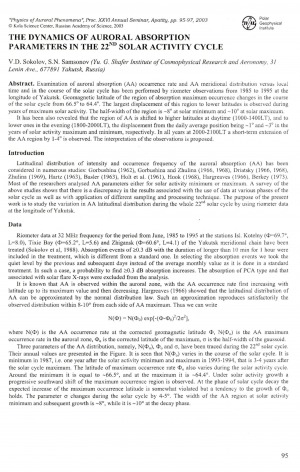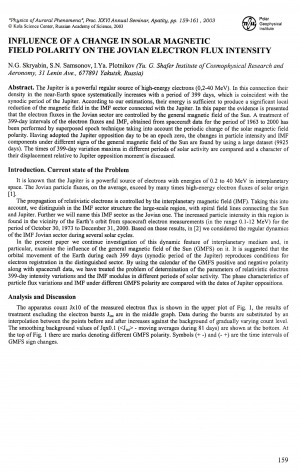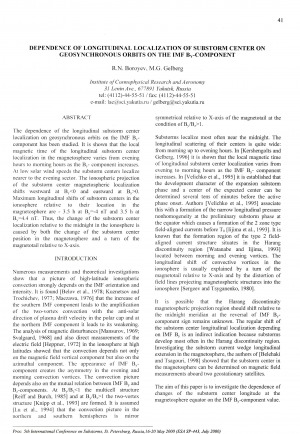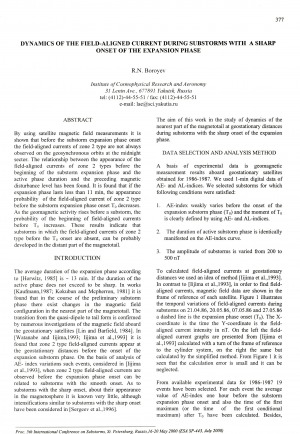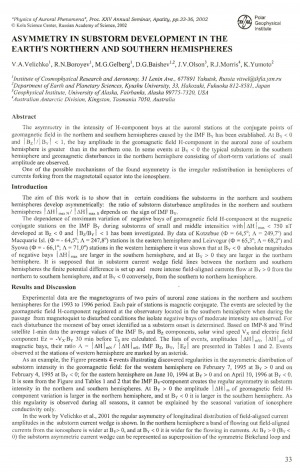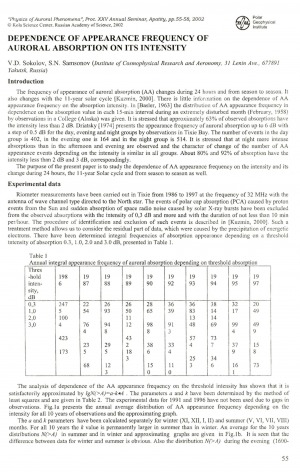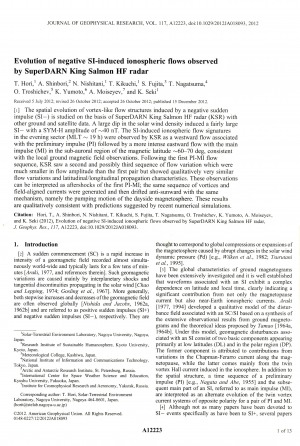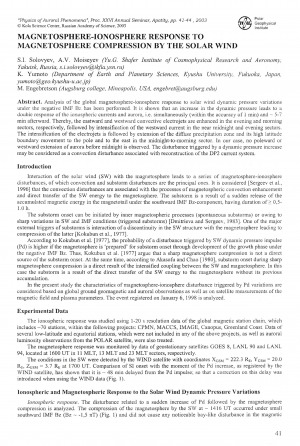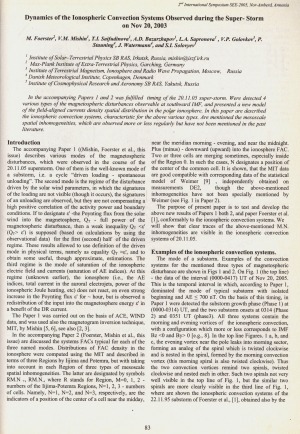Количество страниц: 3 с.
Sokolov, V. D. The dynamics of auroral absorption parameters in the 22nd solar activity cycle / V. D. Sokolov, S. N. Samsonov // Physics of auroral phenomena : proceedings of the 26th annual seminar, 25 - 28 February 2003. – 2003. – P. 95-97.
Количество страниц: 3 с.
Skryabin, N. G. Influence of a change in solar magnetic field polarity on the Jovian electron flux intensity / N. G. Skryabin, S. N. Samsonov, I. Ya. Plotnikov // Physics of auroral phenomena : proceedings of the 26th annual seminar, 25 - 28 February 2003. – 2003. – P. 159-161.
Количество страниц: 4 с.
Boroyev, R. N. Dependence of longitudinal localization of substorm center on geosynchronous orbits on the IMF Bγ-component / R. N. Boroyev, M. G. Gelberg // Proceedings of the Fifth International Conference on Substorms : 16-20 May 2000 Congress Centre of the Arctic and Antarctic Research Institute, St. Petersburg, Russia. − Noordwijk, Netherlands : European Space Agency, 2000. − P. 41-44.
Количество страниц: 4 с.
Boroyev, R. N. Dynamics of the field-aligned current during substorms with a sharp onset of the expansion phase / R. N. Boroyev // Proceedings of the Fifth International Conference on Substorms : 16-20 May 2000 Congress Centre of the Arctic and Antarctic Research Institute, St. Petersburg, Russia. − Noordwijk, Netherlands : European Space Agency, 2000. − P. 377-380.
Количество страниц: 4 с.
Asymmetry in substorm development in the earth's northern and southern hemispheres / V. A. Velichko, R. N. Boroyev, M. G. Gelberg, D. G. Baishev, J. V. Olson, R. J. Morris, K. Yumoto // Physics of auroral phenomena : proceedings of the 25th annual seminar, Apatity, 26 February – 1 March 2002. – 2002. – P. 33-36.
Количество страниц: 4 с.
Sokolov, V. D. Dependence of appearance frequency of auroral absorption on its intensity / V. D. Sokolov, S. N. Samsonov // Physics of auroral phenomena : proceedings of the 25th annual seminar, Apatity, 26 February – 1 March 2002. – 2002. – P. 55-58.
Количество страниц: 14 с.
Evolution of negative SI-induced ionospheric flows observed by SuperDARN King Salmon HF radar / T. Hori, A. Shinbori, N. Nishitani, T. Kikuchi, S. Fujita, T. Nagatsuma, O. Troshichev, K. Yumoto, A. Moiseyev, and K. Seki // Journal of Geophysical Research: Space Physics. – 1978. – 2012 (December), vol. 117, N 12. – P. A12223.
DOI: 10.1029/2012JA018093
Количество страниц: 4 с.
Magnetosphere-ionosphere response to magnetosphere compression by the solar wind / S. I. Solovyev, A. V. Moiseyev, K. Yumoto, M. Engebretson // Physics of auroral phenomena : proceedings of the 26th annual seminar, 25 - 28 February 2003. – 2003. – P. 41-44.
Количество страниц: 3 с.
- Математика. Естественные науки > Астрономия. Астрофизика. Исследование космического пространства. Геодезия,
- Математика. Естественные науки > Геология. Геологические и геофизические науки,
- Прикладные науки. Медицина. Ветеринария. Техника. Сельское хозяйство > Инженерное дело. Техника в целом,
- НАУКА ЯКУТИИ > МАТЕМАТИКА. ЕСТЕСТВЕННЫЕ НАУКИ > Астрономия. Астрофизика. Исследование космического пространства. Геодезия,
- НАУКА ЯКУТИИ > ПРИКЛАДНЫЕ НАУКИ. МЕДИЦИНА. ТЕХНИКА. СЕЛЬСКОЕ ХОЗЯЙСТВО > Инженерное дело. Техника в целом,
- НАУКА ЯКУТИИ > МАТЕМАТИКА. ЕСТЕСТВЕННЫЕ НАУКИ > Геология. Геологические и геофизические науки.
Dynamics of the Ionospheric Convection Systems Observed during The Super-Storm on Nov. 20, 2003 / M. Foerster, V. M. Mishin, T. I. Saifudinova, A. D. Bazarzhapov, L. A. Sapronova, V. P. Golovkov, P. Stauning, J. Watermann, and S. I. Solovyev // Solar Extreme Events Fundamental Science and Applied Aspects Nor-Amberd, Armenia 26-30 September 2005 : proceedings of the Second International Symposium / edited by A. Chilingarian and G. Karapetyan. − Erevan : Cosmic Ray Division, Alikhanyan Physics Institute, 2006. − P. 83-85.
